Microsoft Surface Pro Review
by Anand Lal Shimpi on February 5, 2013 9:00 PM ESTDisplay: Awesome if Calibrated
Surface RT used a 10.6-inch 1366 x 768 display, for Surface Pro Microsoft integrated a full 1920 x 1080 panel of the same size. The increase in resolution is appreciable and you definitely notice it when switching between the two Surface models. Pixel density isn’t class leading, but it’s at least in the right range. On the desktop, Microsoft enables 150% DPI scaling by default which makes everything legible but still a bit odd in applications that don't deal well with fractional DPI scaling. Ideally I would've liked to have seen a clean doubling to avoid this mess.
The higher res display just makes everything sharper in the modern UI, and the 150% DPI scaling in desktop mode makes everything big enough where the higher res isn't a problem there. It's only in those desktop applications that don't properly implement Windows DPI scaling where the higher resolution is a hindrance. I actually ran into this problem using Chrome on the desktop, where my taps wouldn't always map to the right parts of the application (not to mention that Chrome in DPI scaled Windows looks terrible). Thankfully there is always the pen...
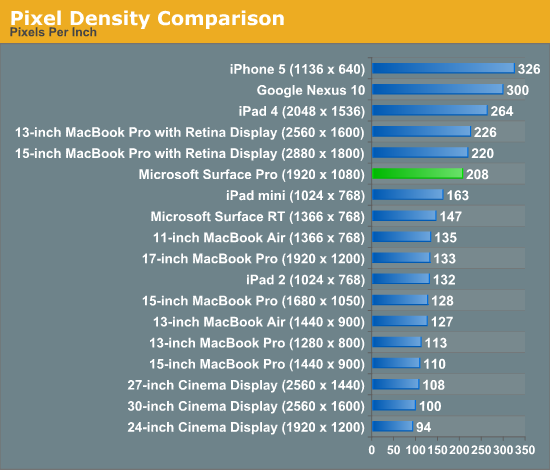
Once again Microsoft doesn’t do any substantial color calibration at the factory, but unlike on Surface RT you can run your own Windows display calibration software on Surface Pro to improve color accuracy if you have the right equipment.
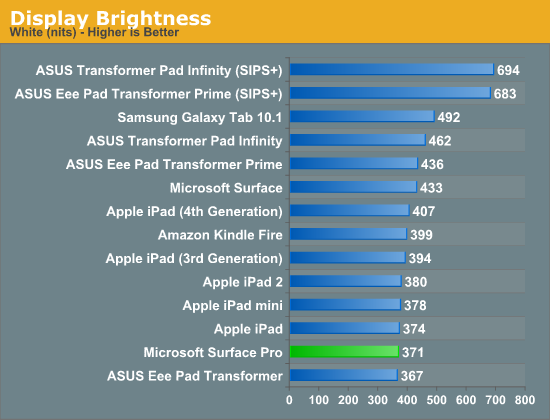
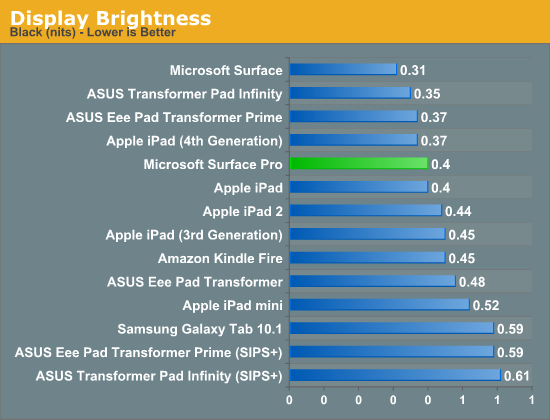
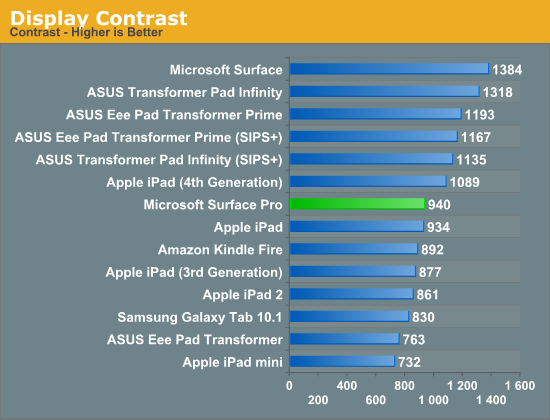
Out of the box my Surface Pro sample had an unusually high white point (~7500K), which negatively impacted its grayscale accuracy. To evaluate color accuracy I turned to our own Chris Heinonen's CalMAN smartphone/tablet workflow. Color accuracy is near identical to Surface RT, which is to say that it’s ok compared to PC notebooks from a couple of years ago but still far behind what you get out of the box from Apple.
Given that the majority of users don’t do any color calibration on their PCs, this becomes a real problem for consumer perception if your tablet doesn’t ship with accurate colors by default.
To see what the panel is capable of I ran it through our standard PC display calibration routine (which I can do since it’s running Windows 8 and is effectively a PC). I then re-ran it through our CalMAN smartphone/tablet workflow and ended up with much more pleasing results. While the display still lagged behind the iPad in one of the tests, it bested Apple’s Retina Display in the other two color accuracy benchmarks.
We'll start off by looking at the calibrated white point for these tablets. What you're looking for here is a number close to 6500K:
The next three charts look at accuracy represented as a difference between various source colors and what's reproduced on the display. The results are presented as average dE2000, with lower numbers being better.
First up is Grayscale performance, here we're looking at the accuracy of black, white and 19 shades of gray spread in between the two extremes:
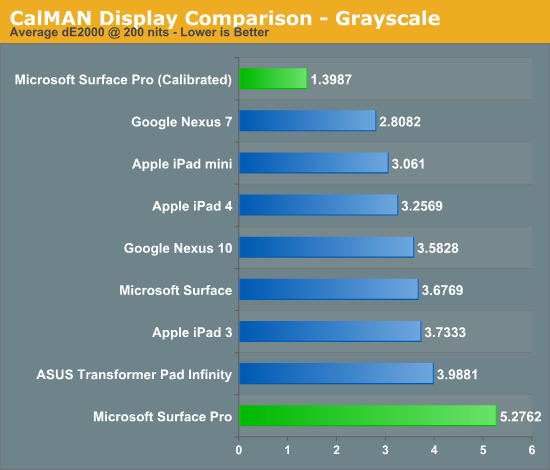
Out of the box grayscale performance is abysmal on Surface Pro. Calibrated accuracy, on the other hand, is just awesome.
First in our color accuracy tests is a saturation sweep. Here we're looking at 20%, 40%, 60%, 80% and 100% saturations of red, blue, green, magenta, yellow and cyan.
Our saturation sweep is the only test where even a calibrated Surface Pro can't match the iPad, it does do a lot better than Surface Pro without any color calibration however. Out of the box Surface Pro is considerably worse than any Apple tablet.
Gamut CIE Chart

Saturation CIE Chart
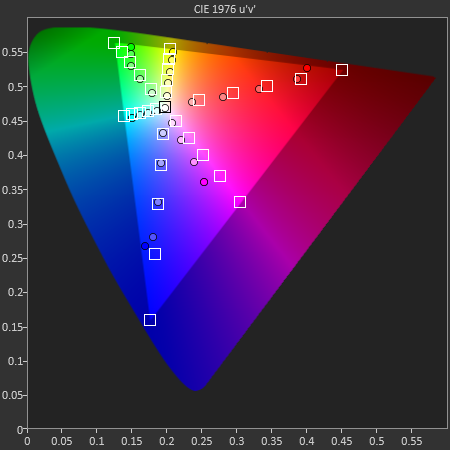
For our final accuracy test we're looking at the difference between a Gretag Macbeth colorchecker chart and the rendered swatches on these displays. Once again, lower numbers are better.
Out of the box Surface Pro and Surface RT are near identical here, and similar to the Nexus 10. With a good suite of calibration tools and supported hardware under Windows 8, Surface Pro has the potential to easily outperform the iPad if given the opportunity.
GMB Color Checker
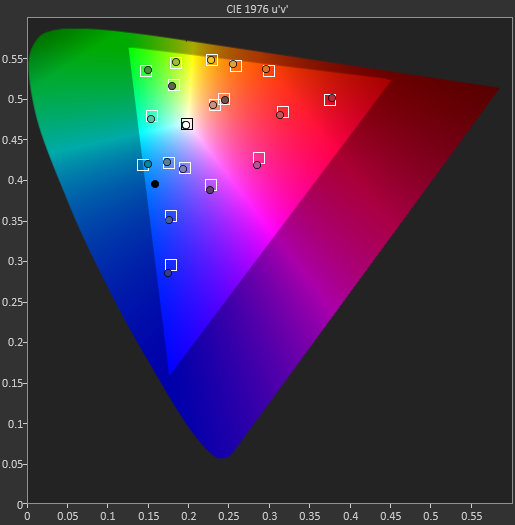
Surface Pro’s panel has real potential, it just needs a calibration pass - which is honestly something Microsoft should be doing these days, not the end user.
Mini DisplayPort but No Thunderbolt
Surface RT featured a single video output in the form of a micro HDMI port. Surface Pro adopts a mini DisplayPort output instead, and will have adapters to enable DVI and HDMI support.
The miniDP output immediately activates as soon as you plug a display into it. I sometimes had issues with display resolutions being set sub optimally, but generally speaking the process was as plug and play as you can get.
I did notice some visual tearing on the Surface Pro display when connected to an external HDMI monitor, similar to what I saw with Surface RT but not nearly as bad. I’m beginning to think something is a bit wonky with Windows 8’s multi-monitor support. What’s interesting is I didn’t see the issue on all displays, which is more than I can say for Surface RT. Update: It looks like this is hardware related. Even if the internal and external panels have the same refresh rate, Intel's HD 4000 won't guarantee that the refreshes will happen at the same time - which is why we see tearing. The tearing should only be present in clone mode, not extended desktop (I'll verify this shortly). It seems like Tegra 3 is worse in this regard, which is why the issue was so much more prevalent on Surface RT. I need to check other Ivy Bridge platforms and under OS X to see if the problem is as prevalent there as well.
The only disappointment here is Microsoft opted against integrating Thunderbolt into Surface Pro. I feel like Thunderbolt would’ve made a ton of sense in a device like Surface Pro, enabling one cable connection to both an external display and high-speed external storage. Given that Thunderbolt adoption remains fairly limited in the PC space I don’t think this is a huge loss for most of Microsoft’s target customer base, but I do feel like it’d be a good way of future proofing the device. The alternative that Surface Pro offers is the combination of miniDP and USB 3.0, which realistically speaking is probably good enough for most users. From a cost of integration standpoint vs. the number of users who would pay for it, it probably didn’t make sense for Microsoft to include Thunderbolt in Surface Pro, but that doesn’t change the fact that I wish it was there. It’d be nice for Apple not to be the only company really pushing Thunderbolt.
Camera Quality
Surface Pro, like Surface RT before it, features two integrated 720p cameras with no flash. Admittedly I didn't spend a ton of time taking photos with Surface Pro but imaging quality is just really bad compared to what you'll get out of an iPad 4. The results are borderline ok for use on the web but that's pretty much it, and forget about decent low light performance.


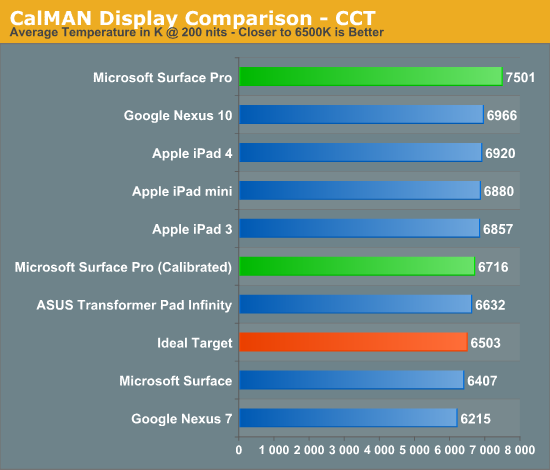
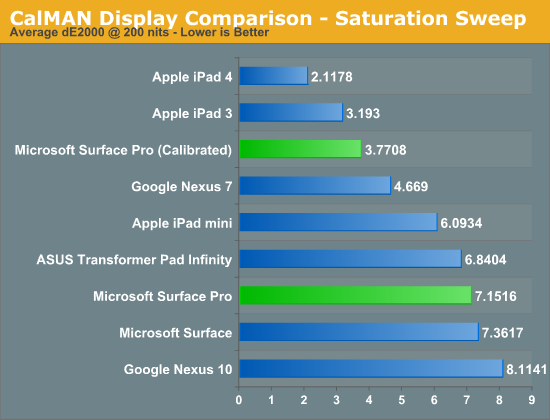
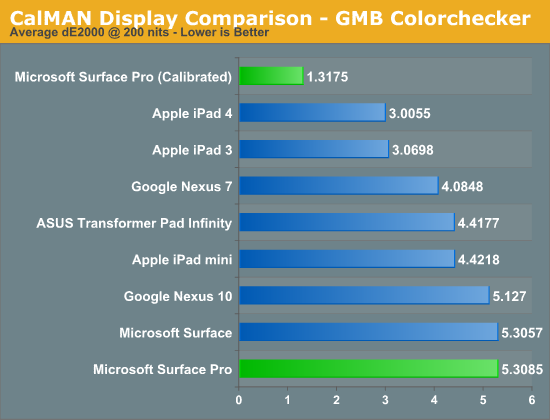










228 Comments
View All Comments
Morgifier - Tuesday, February 5, 2013 - link
The design of the (as yet unreleased) Asus Transformer Book seems preferable, with the external keyboard providing rigidity, additional battery life and extra storage. I wonder if Microsoft have considered this?Although I'm yet to use Windows 8, I do like the idea of device convergence...
cmikeh2 - Tuesday, February 5, 2013 - link
I totally agree with you that Transformer Book seems a lot nicer (especially with the bundled dock) but they're sort of in two different product classes since the Transformer Book (1.9 kg) is about twice the weight of the Surface Pro.althaz - Wednesday, February 6, 2013 - link
If you want something that is three-in-one (desktop replacement, tablet, notebook replacement), the Asus or the Samsung ATIV with similar specs to the Surface Pro are a much better choice.For me though, I never, ever want to type with this thing in my lap. I want to watch videos or play games (mostly Football Manager) while I'm on the train. I want to hook it up to a bunch of XBox controllers and a TV for playing on the multitude of old-school emulator with my buddies, I want to plug a keyboard and mouse into it to play starcraft at my mate's place and my wife wants to surf the internet and play angry birds at home.
I have a desktop at home and at work, this is for everything else which means I don't need the dock (the touch cover would be handy for typing things up when I'm say, on an aeroplane or on a holiday though), or the added weight and price it includes.
I can't wait to get one of these!
jeffkibuule - Wednesday, February 6, 2013 - link
The Samsung ATIV Smart PC Pro has typical Samsung tablet build quality. I wouldn't touch that thing with a 10" pole. Perhaps their Ultrabooks are of better build quality, but the ATIV isn't it.LetsGo - Wednesday, February 6, 2013 - link
Nothing wrong with my Samsung 7.7 Tabs build quality.When they update there 8" Note to a Octo-core I will get one, a tablet should be light therefore being made out of plastic is good design.
B3an - Wednesday, February 6, 2013 - link
Does anyone know when the Transformer Book is actually going to come out? Been waiting for this for ages. Asus are taking the piss. Might just go for Surface Pro.PubFiction - Wednesday, February 6, 2013 - link
IMO, the whole point of surface was to bring to market something the other OEMs were not doing. Transformer is a great form factor, but so what ASUS whom is a big MS partner is already making it why would MS step in and build another transformer when one already exists? The draw to surface is the light ultra thin keyboard. But are you going to get the best typing experience from that? No, of course not, will it be better than typeing with the softboard? Yes.Surface brings one major thing to the table, the ultra thin tablet / laptop combo device. It can do everything, but of course in certain situations it will not be the best device. But compared to the price of other ultra books it is very good. It sports a good CPU, touch screen, digitizer etc. Ultimately you see an over abundance of negative posts which are simply stupid because they compare apples to oranges. People compare this to a mac book air, which has no, touch screen, no tablet mode, and no digitizer. Well duh if all you want is an ultra book then this isnt for you but its ridiculous to even bother comparing a device which is so different and lacks so many features.
What we really need is for the OEMs to fill in the gaps in product lines not try to compete with each other in products that already exists. What we are still missing is a gaming level convertible. Alienware, samsung series 7 gamer, clevo et al. Lenovo has built alot of combinations of tablets and laptops but now we need something sporting at least a 660M that can flip into a tablet and has a built in digitizer.
My biggest complaint with this device has to be the lack of slot for the digitizer pen, the big strength of surface was the compact all in one nature where the keyboard is not a clumsy accessory but an integral part of the device. The pen should have followed that lead.
PubFiction - Wednesday, February 6, 2013 - link
Of course the other issue is non remvable battery which means if you are dropping $900+ on this it wont last more than 2 years before the battery craps out like all sealed batteries.Netscorer - Wednesday, February 6, 2013 - link
most ultrabooks have non-accessible battery. Not sure what your point is. If it is important to you to be able to access memory, storage, battery and other internals, buy a regular laptop, not a tablet.And realistically, batteries last more then two years. The performance may become degraded after some time but I've had batteries lasting 3-5 years on all my devices and by the time they are truly dead, the device is typically obsolete and needs replacement, anyway.
spencer.p - Wednesday, February 6, 2013 - link
That's true.I would recommend perhaps getting a Surface Complete warranty for it (if you get it from the Microsoft Store). $99 for two years of accidental, too.